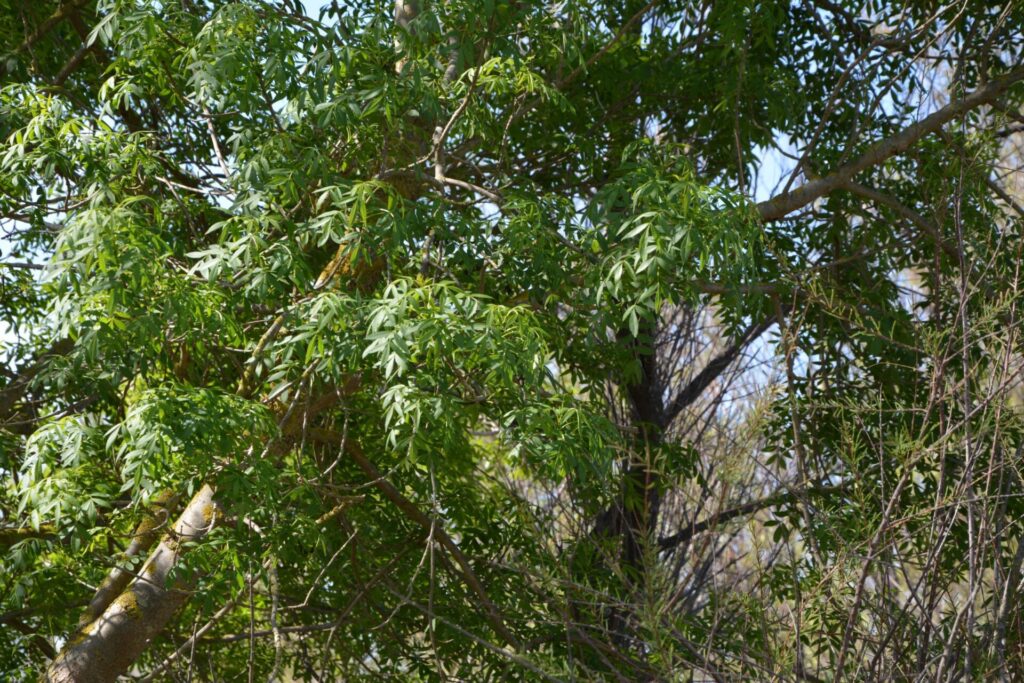Common ash
Fraxinus excelsior L.
Oleaceae
The common ash, Fraxinus excelsior is a tree that can be found throughout a large part of Europe, from southern Scandinavia to Spain. In France, it is fairly common up to 1500m of altitude, except in the Mediterranean region where it is replaced by the narrow-leafed ash, Fraxinus angustifolia Vahl, or the manna ash Fraxinus ornus L. . The common ash is easily recognized by the color of its buds: black for Fraxinus excelsiorand brown for other species*.
The Germanic and Scandinavian people considered this tree to be magical, capable of keeping serpents away or of protecting houses by attracting lightening to themselves. In Nordic mythology, it’s an ash, Yggdrasi, that supports the celestial vaults and is the pillar of the world.
The ash is an extremely useful tree that has been favored or planted in many regions, particularly in the hedges. Its Latin name, Fraxinusis derived from the Greek phraxis meaning “obstacle” or “barrier.”
It is a pioneering tree with rapid growth – up to 80cm a year in its first years. If pruned properly**, its branches will be thick enough to be cut and worked after 3 to 4 years.
Its wood is hard, flexible, and dense. It has been used to make tool handles, bows, skis, tennis rackets… Its reputation for solidity has been noted since antiquity. In Greek mythology, Achilles killed Hector with an ash spear, which bent his shield.
Ash wood is also used for heating because it has a high calorific value and doesn’t need to be dried for long before use.
Ash leaves have been used as animal fodder, especially in mountainous regions. They are rich in protein and available at the end of the season when grass becomes scarce.
In phytotherapy, the leaves are also often used as they possess diuretic and anti-inflammatory qualities. They can be used to relieve rheumatism or gout or as a supplement to detox or weight-loss treatments. Dioscorides (40-90 A.D.) mentioned this latter use: “its leaves, when piled into wine, slim down those who are overweight bit by bit.” Its bark has been used to reduce fever under the name “European quinine,” quinine being the drug of reference for treating fever in the nineteenth century.
Ash is now threatened in many regions by a disease caused by Hymenoscyphus pseudoalbidus. This microscopic fungus, doubtlessly introduced by imported wood from China, develops rapidly and causes the withering and death of numerous trees. This epidemic could affect 99% of French ash trees in the next fifteen years. Many other species are indirectly affected as ashes shelter and nourish various birds and insects.
Luckily, some trees seem to resist the disease and can help with repopulation.
Voici une recette historique de « boisson de ménage », la frênette.
Traditional ash cider
Ash cider, also called frênette, is a fermented, slightly alcoholic drink (3 to 4%).
Take 1kg of dry ash leaves harvested on a hot day in August. At this time of year, the leaves are glossy and rich in sugar.
Place them in a large recipient.
Add 10 liters of hot water (40°C).
Cover the recipient with a cloth.
After 24 hours, stir (to help dissolve the natural sugars in the leaves)
Let ferment at 20°C for 5 to 6 days.
Filter until clear and put into lemonade bottles.
Wait 2 weeks before drinking.
*If you harvest for l’Herbier du Diois, we can provide you with a botanical identification sheet for the different species of ash.
**The trunk is cut at a few meters high to encourage the growth of offshoots.
